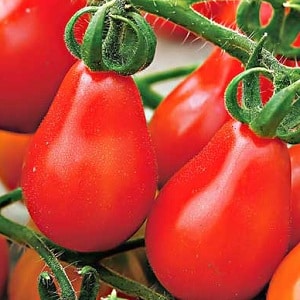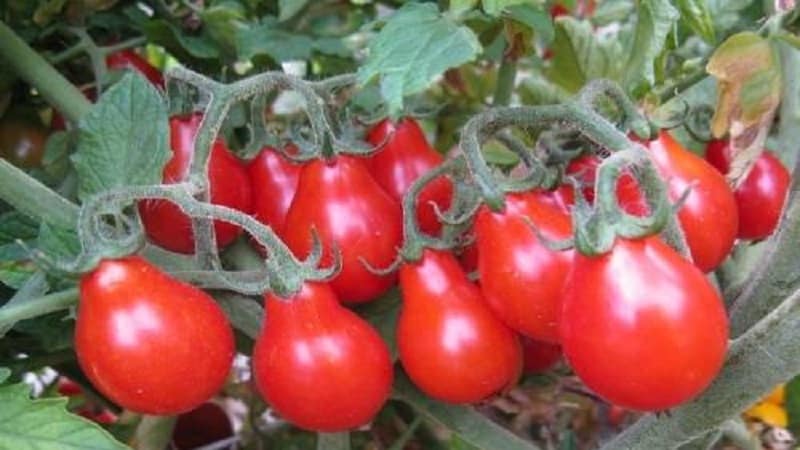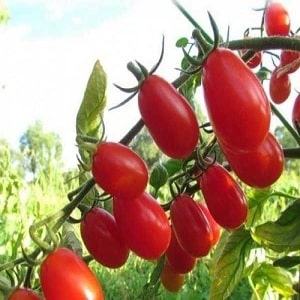How to grow the “Red Pear” tomato on your own plot: review of the variety and secrets of care from experienced gardeners
Among the variety of shapes, colors and varieties, the red pear stands out. The fruits have an unusual shape and combine the classic characteristics of tomatoes: rich sweet and sour taste, bright red skin, dense and juicy pulp without voids with a small number of seeds. The variety is popular among summer residents due to its ease of cultivation and versatility of use.
From the article you will learn about the advantages and disadvantages of the crop, the rules of cultivation in the garden and greenhouse.
Description of the variety
The mid-season variety Red Pear was bred by breeders of the Research and Production Corporation NK.Ltd.
Introduced into the State Register of the Russian Federation in 2000. The crop is intended for cultivation in small and large farms in closed and open ground.
The plant is indeterminate and needs staking and shaping.
The photo shows the fruits of the Red Pear variety.

The distinctive features of the variety are presented in the table.
| Indicators | Characteristic |
| Weight | 45-70 g |
| Form | Pear-shaped |
| Coloring | Red |
| Leaves | Medium size, green |
| Type of inflorescences | Simple |
| peduncle | With articulation |
| Number of slots | 2-3 |
| Pulp | Dense, high in dry matter, but juicy |
| Taste | Classic sweet and sour |
| Skin | Smooth, dense, does not crack |
| Purpose | Universal |
| Bush height | In open ground - 1.3 m, in closed ground - 1.5-2 m |
| Ripening period | 110-115 days |
| Productivity | 5-7 kg/m² |
| Sustainability | To verticellosis, tobacco mosaic virus, fusarium |
| Transportability | Excellent |
Growing seedlings
Sowing seeds is done in two ways: in seedling boxes and directly into the ground. The first method is used in the northern regions and areas of the middle zone. The second method is practiced in the south of the country.
Preparing soil and seeds
Sowing work is planned approximately 2 months before transferring the seedlings to a permanent place. The optimal period is the last ten days of February or the first ten days of March. Seeds collected by hand from previously grown tomatoes are processed. They are soaked in a slightly pink solution of potassium permanganate for 2 hours, then washed with clean water.
Seeds in packaging are processed in production.
Soaking in germination stimulants: “Epin”, “Zircon”, “Immunocytophyte” will not hurt. Folk remedies are also popular:
- Aloe juice is diluted with water in a 1:1 ratio and the seeds are immersed in the solution for 4-6 hours.
- A teaspoon of bee honey is dissolved in 200 ml of warm water and the grains are soaked for 5-6 hours.
The soil for growing seedlings is prepared from equal parts of turf, peat and river sand, or a ready-made substrate is used in bags marked “universal”. The soil, prepared independently, is fertilized with organomineral compositions “Ogorodnik” and “Universal”. They contain substances necessary for rapid growth and nutrition of plants: potassium, magnesium, phosphorus, sodium, sulfur, iron, zinc.
Advice. For the purpose of disinfection, the soil mixture is calcined in an oven at a temperature of 100-110 ° C or filled with a strong solution of potassium permanganate.
Sowing
The seedling boxes are filled with moist soil and the seeds are placed in furrows 2 cm deep at a distance of 2-3 cm. Sprinkle the top with a 1 cm layer of soil and cover with glass or cling film. The boxes are taken to a dark place.The seeds hatch after 4-5 days at a room temperature of 25 °C.
The cover is removed daily to ventilate the soil and prevent mold.
Seedling care
After the sprouts appear, the boxes are placed in a sunny place.. They try to maintain the air temperature within 22 °C. If there is a lack of sunlight, phytolamps are installed above the seedlings at a height of 60-70 cm.
Seedlings are transplanted into individual pots after the first true leaf appears. Plastic containers or peat glasses are suitable for this purpose.
Seedlings are provided with moderate watering 1-2 times a week. Fertilizers “Agricola” and “Effekton” are used for feeding once every 14 days.
Agricultural technology of tomatoes
The rules for growing the variety are standard: removing the shoots, shaping the plants into 2 stems, tying them to stakes or trellises, moderate watering and fertilizing.
Landing
Transferring seedlings to the greenhouse begins in late April or early May, and to open ground - at the end of May or early June. The soil should warm up to a temperature of 16-18 °C. In the first week after planting, the crop is provided with gentle conditions: shaded from the scorching sun and protected from drafts.
Soil preparation begins in the fall. The area is dug up and one 10 liter bucket per 1 m² is added. In spring, the soil is loosened again and fed with humus - 10 liters per 1 m².
Reference. To plant bushes, select an area where white cabbage, cauliflower, peas, beans, parsley, and onions were previously grown.
Holes for seedlings are dug at a depth of 15-20 cm, filled with a concentrated solution of potassium permanganate or boiling water, and 3-5 g of superphosphate are added. The seedlings are moistened abundantly and transferred into holes with a lump of earth.Seedlings in peat pots are planted directly into them. The soil is poured to the level of the lower leaves. This helps the plant take root faster.
Planting pattern – 40x60 cm, 3 bushes per 1 m².
Care

Regularity is important in caring for Red Pear tomatoes. Plants are watered moderately, fed with organic matter and mineral compounds, hilled up to strengthen the root system, loosen the soil and remove weeds.
Helps make caring tasks easier mulching soil with agrofibre, straw, hay, sawdust, pine needles. Mulch inhibits the growth of weeds, prevents the formation of a hard crust on the surface after watering and prevents late blight infection.
Tomatoes are earthed up 10 days after planting, after thoroughly moistening the soil. Repeated hilling is carried out after 14 days.
Water calculation for each tomato bush is 1 liter. Pear-shaped varieties do not tolerate overwatering. Excessive moisture leads to rotting of the rhizomes, and the fruits also begin to deteriorate.
For fertilizing use organic matter and mineral fertilizers (once every 2 weeks):
- The first portion of nitrogenous fertilizers is applied 14 days after planting - 1 liter of mullein, 1 liter of green fertilizers (based on tops and mown grass), 1 liter of ash per 10 liters of water.
- Subsequent feeding is carried out with ready-made mineral compositions every two weeks: “Kemira”, “Rastvorin”, ammophos, nitrophoska, nitroammophos. The dosage and method of use are indicated on the packaging.
The bushes are regularly planted and formed into 2 stems. This technique allows you to obtain a consistently high yield. The lower leaves are regularly plucked off to improve air exchange.
Plants are tied to tall wooden stakes or trellises.
Features of cultivation
The Red Pear variety is grown without seedlings, following the recommendations:
- Tomatoes prefer loose and nutritious soil. The soil is dug up 2-3 weeks before sowing and potassium-phosphorus fertilizers are applied. The area is sprinkled with wood ash at the rate of 2 kg per m².
- The seeds are placed in holes 1.5 cm deep at a distance of 40 cm.
- After sowing, the soil is moistened abundantly with warm, settled water and covered with film or lutrasil.
- After warm weather sets in, the shelter is removed.
- Seedlings are thinned out if necessary and weak shoots are removed.
- Further care includes feeding, weeding, watering and loosening. During fruiting, watering is limited to prevent cracking of tomatoes.
- Garter produced when the height reaches 40-50 cm.
Reference. Lutrasil is a modern covering material. Made from polymer threads tightly woven together. Protects plants from sub-zero temperatures, retains heat, and allows moisture and air to pass through perfectly.
Diseases and pests
The Red Pear variety is resistant to fusarium, verticillium, and tobacco mosaic virus. Preventative measures will protect plants from late blight infection.
Signs of the disease:
- brown spots with a gray tint on stems, leaves, fruits;
- white coating with edges on the back of the leaves;
- deformation of tomatoes.
Methods of prevention and control:
- soil disinfection with copper sulfate (50 g of substance per 10 l of water, consumption per 1 m² - 2 l);
- treatment of greenhouses with sulfur bombs;
- removal of lower foliage;
- humidity level control;
- organization of drip irrigation;
- mulching with sawdust, peat, agrofibre, pine needles, straw.
To combat insect pests (aphids, spider mites, whiteflies) use:
- insecticides - “Aktara”, “Sirocco”, “Decis Profi”, “Mospilan”, “Borey”, “Iskra”, “Epin”;
- biological preparations – “Fitoverm”, “Bitoxibacillin”, “Fitosporin-M”, “Nemabakt”.
The nuances of growing in open ground and in a greenhouse
The agricultural technology of tomatoes in protected and unprotected soil is not fundamentally different.
The period for transferring tomatoes into open and closed ground varies depending on the region of growth. In the northern regions and regions of the middle zone, planting is carried out in early May in greenhouses. In the southern regions, seedlings are planted in open ground in early June. For planting, choose a sunny area without drafts.
The greenhouses are kept open during the day and closed at night.
After the fruits appear, the frequency of watering is reduced to once a week. In dry weather, plants are watered more often.
Harvesting and application
Tomatoes begin to ripen 110-115 days after germination. The fruits are characterized by excellent taste and are suitable for making juice, ketchup, sauces, adjika, lecho, salads, vegetable caviar, pasta. Small tomatoes fit easily in a jar and do not crack during heat treatment.
Thanks to their dense pulp and high dry matter content, tomatoes are ideal for making dried snacks in olive oil.
Advantages and disadvantages
Advantages:
- high productivity;
- original shape of tomatoes;
- suitable for cultivation in protected and unprotected soil;
- disease resistant;
- long-term storage (up to 2 months at a temperature of 2-3 ° C);
- resistant to changes in average daily temperature;
- excellent taste.
The disadvantage is the need to form the bushes into 2 stems and tie them to the supports.
Other varieties of the variety
The table contains the main characteristics of other varieties from the Pear series.
| Yellow | Orange | Black | Pink | Honey | |
| Ripening period | 100-110 days | 95-115 days | 110-125 days | 110-115 days | 90-100 days |
| Bush height | 2-2.5 m | 1.5-1.8 cm | 1.6-1.8 m | 1.5-2 m | 1.2-1.5 m |
| Skin | Dense | Dense | Dense | Dense | Dense |
| Weight | 80-100 g | 40-60 g | 60-100 g | 80-100 g | 30-40 g |
| Coloring | Yellow | Bright orange | Burgundy brown | Pink | Yellow |
| Taste | Sweet | Sweet, sour | Very sweet | Sweet | Sweet |
| Productivity per 1 m² | 6-8 kg | 6-7 kg | 6-8 kg | 6-7 kg | 7-8 kg |
All crops are distinguished by ease of care, productivity and long shelf life of fruits, absence of voids and a small number of seeds.
Orange pear tolerates heat and cold better than others. The fruits of the Black Pear variety have a unique rich color and contain an increased amount of sugar.
Reviews
Feedback from farmers about the Red Pear variety is mostly positive.
Valentina, Dzerzhinsk: “I grow Pear in a greenhouse. I prefer to buy seeds so as not to bother with preparations for the next season. I plant red and yellow tomatoes, and then seal them in a marinade for the winter. This preparation looks great in a jar. The variety is easy to care for and rarely gets sick. The taste of the fruit is rich, sweet and sour.”
Ivan, Sosnovy Bor: “Red Pear tomatoes are my favorite variety. Easy to care for, disease resistant, combined with an original shape and excellent taste. All this helped the culture take pride of place in my greenhouse. During 5 years of cultivation, the plants became infected with late blight only once, but the problem was quickly resolved by treating them with Fitosporin. We eat tomatoes fresh and can them.”
Conclusion
The Red Pear tomato from the series of pear-shaped varieties of the same name is endowed with unique characteristics: original shape, rich taste, versatility in cooking, excellent shelf life and ease of care.
Following the rules of regular watering and fertilizing allows you to get a high yield without much labor.